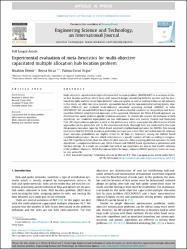Experimental Evaluation of Meta-Heuristics for Multi-Objective Capacitated Multiple Allocation Hub Location Problem
Künye
DEMİR, İbrahim, Berna KİRAZ & Fatma Corut ERGİN. "Experimental Evaluation of Meta-Heuristics for Multi-Objective Capacitated Multiple Allocation Hub Location Problem". Engineering Science and Technology, an International Journal, 29.5 (2022).Özet
Multi-objective capacitated multiple allocation hub location problem (MOCMAHLP) is a variation of classic
hub location problem, which deals with network design, considering both the number and the location
of the hubs and the connections between hubs and spokes, as well as routing of flow on the network.
In this study, we offer two meta-heuristic approaches based on the non-dominated sorting genetic algorithm
(NSGA-II) and archived multi-objective simulated annealing method (AMOSA) to solve
MOCMAHLP. We attuned AMOSA based approach to obtain feasible solutions for the problem and developed
five different neighborhood operators in this approach. Moreover, for NSGA-II based approach, we
developed two novel problem-specific mutation operators. To statistically analyze the behavior of both
algorithms, we conducted experiments on two well-known data sets, namely Turkish and Australian
Post (AP). Hypervolume indicator is used as the performance metric to measure the effectiveness of both
approaches on the given data sets. In the experimental study, thorough tests are conducted to fine-tune
the proposed mutation types for NSGA-II and proposed neighborhood operators for AMOSA. Fine-tuning
tests reveal that for NSGA-II, mutation probability does not have a real effect on Turkish data set, whereas
lower mutation probabilities are slightly better for AP data set. Moreover, among the AMOSA based
neighborhood operators, the one which adds/removes a specific number of links according to temperature
(NS-5) performs better than the others for both data sets. After analyzing different operators for both
algorithms, a comparison between our NSGA-II based and AMOSA based approaches is performed with
the best settings. As a result, we conclude that both of our algorithms are able to find feasible solutions
of the problem. Moreover, NSGA-II performs better for larger, whereas AMOSA performs better for smaller
size networks.
Kaynak
Engineering Science and Technology, an International JournalCilt
29Sayı
5Bağlantı
https://www.sciencedirect.com/science/article/pii/S2215098621001440https://hdl.handle.net/11352/3791



















